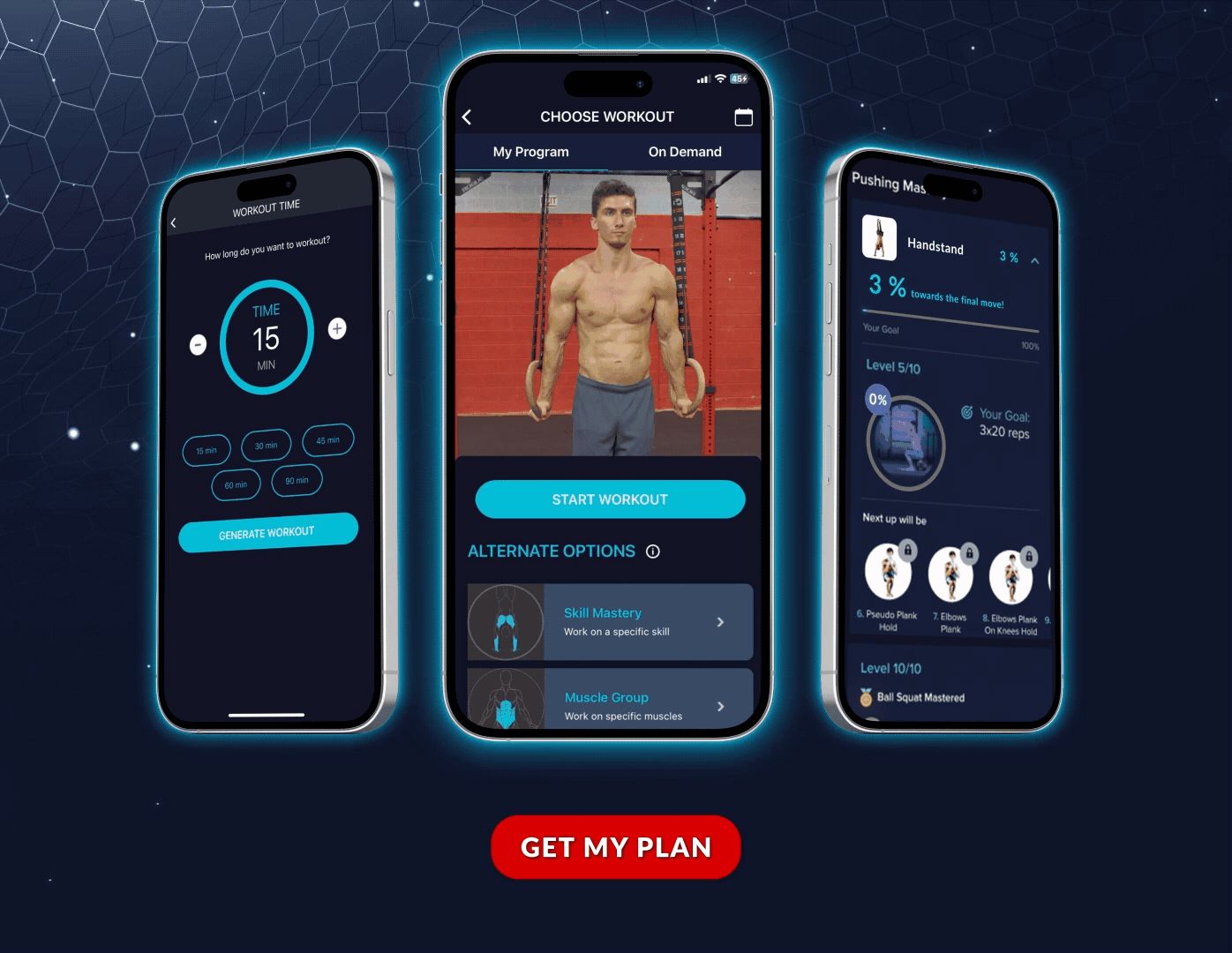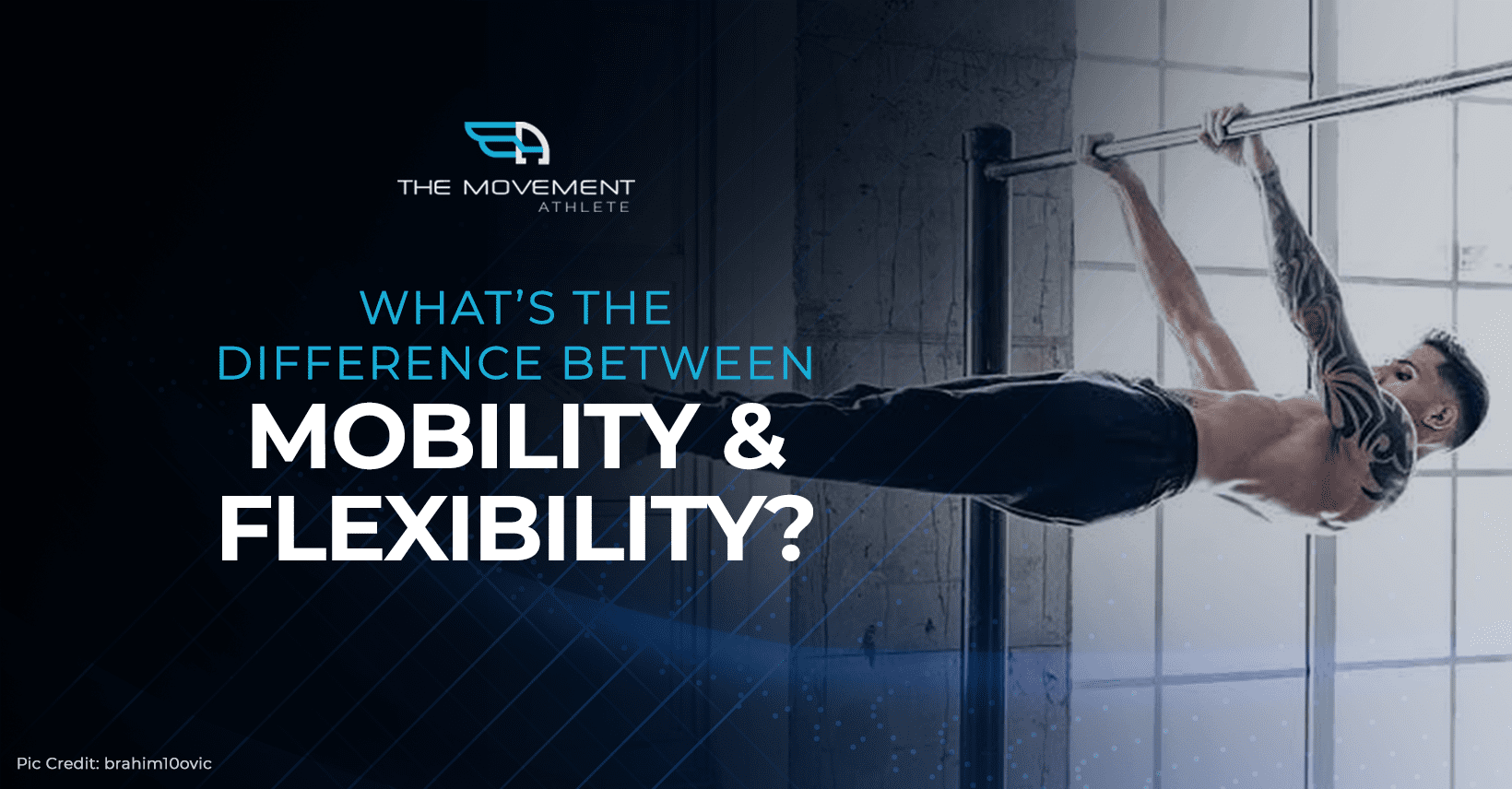

📖 Read Time: 8 Minutes
🏋️ Join the tribe of Movement & Calisthenics Athletes
People just like you that are working with their own body weight to get strength, lose fat, build muscle, recover from injuries and live their best lives!
Which one should you focus on for better movement and more comfortable life? 🤔
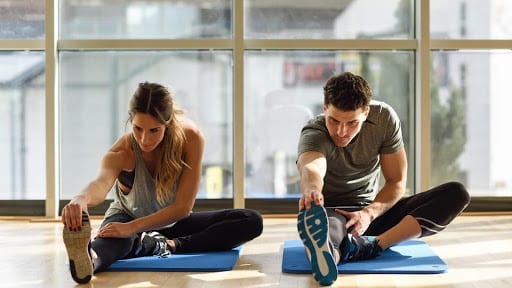
Ah yes, mobility and flexibility: you’ll usually hear these terms thrown in your gym or yoga class. They are generally used to describe “bendy” individuals that can perform acrobatic moves or hit seemingly impossible yoga poses. 🤸♀️
One of the most common misconceptions in the fitness industry is the interchangeable use of these terms, while in fact, the two are quite different.
But these two go hand in hand and are equally essential to have an overall healthy body comfortable with movement even for us regular folk who are not necessarily aiming to achieve a body that you can turn into a pretzel. 🥨
Let’s talk about their differences, importance, and how to improve the two aspects to achieve a strong body capable and comfortable movement that will last for years.
☝️ Main Difference between the two:
👉 Flexibility
Flexibility refers to an individual’s ability to stretch their soft tissue (muscles) and move the joints passively in a given range of motion.
Suppose you’re trying to move to a specific range of motion with the assistance that’s general flexibility. For example, if you’re sitting down on the floor and trying to reach your toes while someone is pushing you down or if you grab your leg from behind and hold it using your arm, similar to the photo below, that’s flexibility.
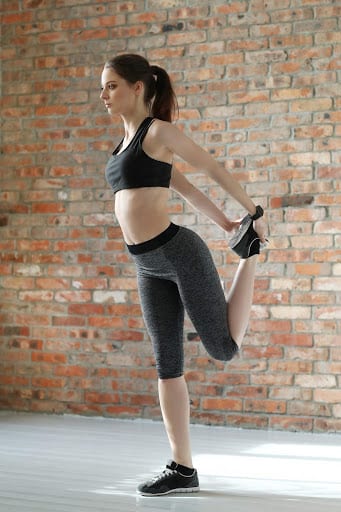
An athlete is stretching to show her quadricep flexibility. Notice her hands pulling to get a deeper stretch and increase the range of motion
Whatever assistance it may be to help you reach a position, whether it be your arm, a band, the floor, another person, or weights, as long as you have an external force assisting you, flexibility is the system applied to the movement.
Your muscles aren’t actively doing the movement, and it’s passively reaching the end range of motion through the external forces applied.
Why Flexibility is Important
Having adequate flexibility plays an essential role in improving your mobility.
For you to move to a specific range of motion, your muscles must have the capacity to lengthen without strain and pain. This is where flexibility comes in.
Whether you’re aiming for a specific skill or performance-based movements, or you just want to be able to move comfortably in your everyday life, flexibility must be regularly trained and implemented in your routine.
It’s also a great way to relax, as a study indicates that muscle stretching could lead to relaxation, ultimately alleviating stress. 😌
📌 How to Improve Flexibility
Holding static, passive stretches is a fantastic way to develop flexibility, but you have to do it the right way.
Most of us learned from gym class that we must stretch first as part of our warm-up before starting our exercise routine. Note that static stretching is usually incorporated, which means holding a specific end range of motion for some time.
Unfortunately, studies show that doing static stretches before a routine is dangerous and detrimental to your performance and gains! Muscle fatigue also sets in earlier when static stretches are implemented before an activity. ⚠️
So the best time to train flexibility is after your workout, so your muscles are warm and supple enough for the stretch.
If you want to focus on flexibility, just be sure to do warm-up exercises to target the muscles you will train for flexibility. Ready to start improving your flexibility? Take our free assessment to get a personalized plan that includes flexibility training tailored to your needs.
👉 Mobility
Remember the photo in the flexibility section in which the woman was stretching her quads? The mobility counterpart of this exercise is when you perform the movement WITHOUT grabbing your foot. Try it yourself! You’ll find it much more challenging to maintain the range of motion without the assisting arm. You’ll also notice the difficulty to maintain balance and coordination as well! 🤯
Mobility is a broader term that accounts for a full range of motion with active control. This considers much more than just the flexibility of the muscles. Mobility also includes joint stability, overall strength, balance, and coordination.
An athlete can be very flexible but lack overall mobility.
Having mobility translates to a better and more comfortable movement, so most people strive to improve their mobility.
📌 Why Mobility is Important
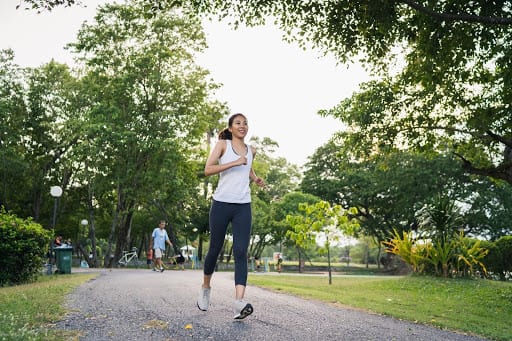
Mobility transfers to every movement and position, including a walk in the park. You will feel the difference once you have improved your mobility.
• ✅ Reduce the risk of Injury – Being mobile means having more stable joints capable of handling the demands of doing a wider range of motion. It’s a matter of having control of your movements. Studies support this claim as a wider range of motion extends your limit of movement.
• ✅ Improve the quality of movement – With a greater range of motion, you’ll feel your muscles and joints less stiff when performing even the most basic tasks or even just standing comfortably.
• ✅ Unlocks skills with mobility demands – There are tons of calisthenics skills and even in other disciplines that require good general and specific mobility. This is why if you’re aiming for performance, it is a must to train mobility and not just the strength and technique of a move.
• ✅ Improves posture – Studies have already been made that correlate poor hip, leg, spine, or even shoulder mobility to poor posture. If you want a strong, comfortable, and proper posture, build the necessary mobility in the right areas.
Once this issue has been addressed by improving the problematic area’s mobility, posture improvement will be visible.
• ✅ Minimize future aches and pains – There are tons of people enduring avoidable aches and pain through the years just because they don’t have the proper mobility in certain areas.
One study has shown that most back and shoulder pain is due to poor mobility.
The pain is no laughing matter and can’t be shrugged off. Luckily, these can be resolved by improving the mobility of specific areas such as the neck, shoulders, spine, hips, and legs. It sounds a lot but working on mobility is a big pay off and worth the effort. 💪
• ✅ Prepares your joints for the years to come – Effects of time on our joints is inevitable. Slow degradation of joint quality starts as early as 30 years old!
Unfortunately, we cannot stop this process, definitely slow it down through constant use of the joints and training them to extend the maximum attainable range.
How to Improve Mobility
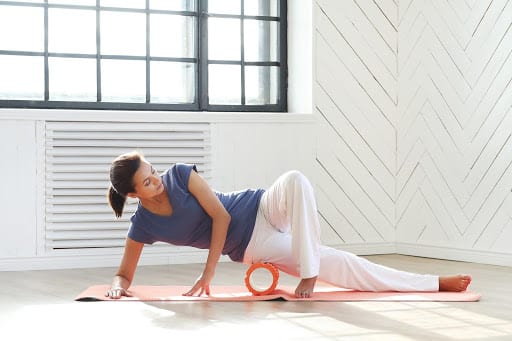
Foam rolling is one of the effective methods of increasing mobility. You might feel some discomfort but lasting effects are worth it.
• ✅ Dynamic warm-ups – Ditch the static stretches in your warm-up and replace them with your dynamic ones. Not only will it prime your muscles and joints for the upcoming demands, but you also get to improve your mobility by challenging the range of motion with minimal loading.
• ✅ Mobility drills – This would be your best bet especially for specific muscles that you rarely use (usually these are also the weak links that hinder your progress or brings pain in your everyday life). Mobility drills are designed to improve overall joint stability, and muscle strength in a wider range of motion. These are usually started off lightly so you can slowly increase your range of motion without forcing through momentum or have the risk of injury.
• ✅ Full range of motion of exercises – Yes, it could be easy as that! Take regular push-ups for example. Performing it with perfect, full form strengthens not only the targeted muscles but also the shoulder joint in that range of motion.
So remember to always aim for the perfect form. If you’re having trouble reaching the complete range of motion, you can do two things: 1, ease your way into the full range. 2, use specific mobility drills that might be hindering your form.
• ✅ Improving flexibility – As mentioned earlier, training flexibility could also lead to mobility gains. It’s basically making your muscles more “elastic” so it can have the ability to elongate for you to reach the range of motion. This is done by, as mentioned earlier, doing static stretches.
Just remember that flexibility isn’t enough. Mobility is flexibility with strength, balance, coordination, and control.
• ✅ Myofascial release and foam rolling – Sounds fancy, but it’s just basically a type of self-massage with a foam roller that helps release tightness in the joints and muscles. The release assists in helping your muscles and joints keep loose. You might feel a ton of discomfort with these type of exercise when you have a lot of tightness, but you’ll thank me later after recommending this.
Which one should you focus on? 🙄
Both factors are vastly important to be able to move more efficiently.
Without mobility, your flexibility is worthless as you can’t back up your flexible muscles with proper strength, joint stability, control, and coordination.
Without flexibility, you might not achieve your target mobility as your muscles are unable to lengthen to your desired range of motion.
Without both, obviously you’ll have a very hard time in your life.
That being said, you must find a balance of training both flexibility and mobility to guarantee an overall healthy body that’s free of injuries and comfortable with a wide range of motion for a lifetime.
If you need a program that can help you with both flexibility and mobility for a lifetime, check out our free assessment for a personalized training plan that addresses both aspects. Not only you’ll get to improve both, you can also build real-world strength, a gymnast’s physique and bullet-proof joints. 💪
💡 Key Takeaway: Mobility and flexibility work together – flexibility provides the range, while mobility gives you the strength and control to use that range effectively. Both are essential for injury-free movement and long-term joint health.
Related Articles You’ll Love:
Ready to get started?
Get your free personalized training plan now
